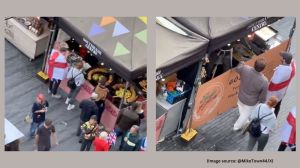Mixed blessing
The three main contenders for the post of CBI director are K K Paul, the Delhi Police Commissioner, R S Mooshahary, DG, BSF, and J K Sinha, ...

The three main contenders for the post of CBI director are K K Paul, the Delhi Police Commissioner, R S Mooshahary, DG, BSF, and J K Sinha, DG, CRPF. Sinha appeared to have a headstart since Laloo Prasad Yadav was pushing hard for his appointment. But Sinha’s closeness to Laloo has now got him into hot water and may have knocked him out of the reckoning. The Election Commission has written to the Government requesting that the role of the DG, CRPF, in the Bihar campaign be probed.
The Election Commission’s letter comes in the light of Opposition charges that Laloo sneakily met two senior CRPF officials at midnight and a CRPF vehicle was used to transport money for an RJD candidate.
Money, not men
Even if Narendra Modi and Shatrughan Sinha are not part of the Bihar campaign, the BJP has a long list of speakers ready for barnstorming, from Vajpayee and Advani to Navjot Singh Sidhu and a two-foot dwarf. But Nitish Kumar is not really interested in the BJP’s offer of campaigners to pitch in on behalf of JD(U) candidates. He wants the BJP generosity not in manpower but in money.
However, the BJP is keeping a tight grip on its election budget and is unwilling to lavish its limited resources on an undependable ally. The BJP’s favourite in the JD(U) is George Fernandes who has practically no role in this election. Kumar and Sharad Yadav have complete control over the JD(U) campaign and ticket distribution. Fernandes though nominally president of the party, is largely irrelevant.
Up down trajectory
Vice President Bhairon Singh Shekhawat released a book on physics by O P Pandey, a BJP loyalist, at his residence last week. Shekhawat confessed that though he had sat up through the night reading the document, he could not comprehend the references to the paths of the electrons, protons and neutrons. ‘‘I can’t understand who’s up and who’s down. Maybe Joshiji can enlighten us,’’ he said referring to the fact that Murli Manohar Joshi is a physics professor. The audience burst out laughing since the Vice President’s remark clearly had a double meaning and was an allusion to the present warfare in the BJP on the leadership issue.
Murli Manohar Joshi, a perennial candidate for party president and a Hindutva hardliner who is a die-hard Advani opponent, responded with the remark, ‘‘Time will tell, who is up and who is down.’’
Our MY combine
The BJP and JD are campaigning separately for the Bihar polls except for occasional joint rallies. With one exception. The JD(U)’s Sharad Yadav and the BJP’s Shahnawaz Husain have formed a twosome and have been addressing several election meetings together. A BJP leader proclaimed proudly that this is ‘‘our MY (Muslim-Yadav) combine’’. Laloo Yadav of course has another take on the partnership. He dismisses both Sharad, who is a Yadav from Madhya Pradesh, and Husain, a lone Muslim in the Hindutva BJP, as asli naklis (original fakes).
A different angle
Everyone is familiar with photos of the Nehru Gandhi family from every angle and on every major occasion in the last 100 years. But an enterprising generation next publishing editor Priya Kapoor has succeeded in digging up some rare pictures from the archives which have never been made public before. Kapoor, who is planning to bring out a book by Republic Day, has gained access to the family albums of Fori and Swarup Nehru. She has also discovered hidden treasures in the archives of the Teen Murti Marg Library and the Southampton Collection in England which was donated by the Mountbatten family.
The new cache of photos include a sepia print of the entire Nehru clan shot in December 1911. Motilal Nehru, the father of the man who popularised the Nehru jacket, sticks out because he is attired like a tip-top Englishman complete with breaches, long socks and a hat, while, everyone else in the group is wearing Indian clothes. Snapshots of Jawaharlal Nehru and Edwina Mountbatten sunbathing are also collector’s items. In one picture, Nehru hams it up for the camera donning a hat with his swimming trunks. A photograph of Indira Gandhi calling on President Radhakrishnan, with her face completely bandaged, is bound to arouse curiosity. This shot was taken in 1967 when she was hit on the nose by a stone during an election rally in Orissa.
Electing to go electronic
The Election Commission has introduced digital cameras in the polling stations in Bihar and a snapshot is automatically taken of any person entering the booth. The film is a ready reference to check out complaints of bogus voting. By the next election, the EC hopes that with the help of BEL and the National Informatics Centre a software will have been devised by which a digital camera will be able to instantly verify whether the person carrying a voter ID card is genuine.
In another electoral reform, the EC now utilises electronic maps provided by security agencies to figure out the contours of a constituency. Politicians can no longer include their pocketboroughs, when they are at some distance from the rest of the constituency. During the ongoing delimitation exercise, the electoral map is decided solely on the basis of proximity from the epicentre. The fact that Election Commissioner N Gopalaswamy is an electronic engineer by training may have helped bring about these significant innovations.
Photos





- 01
- 02
- 03
- 04
- 05


























